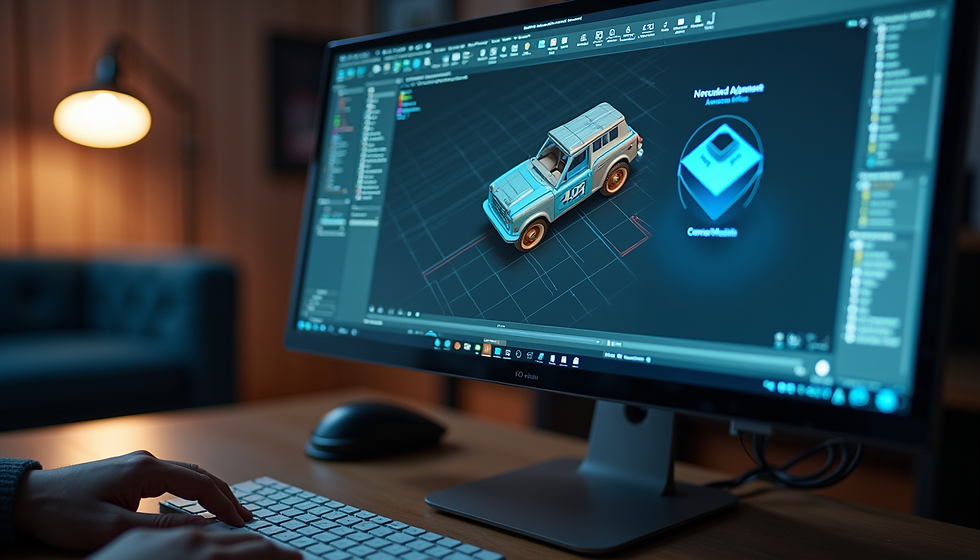From Sewing to Sampling: How the Fashion Industry Went Digital and What it Means for Designers
- chinmayee n
- Mar 23
- 4 min read
The fashion industry is experiencing a remarkable shift. It is moving away from traditional manual processes and embracing digital approaches, transforming how designers create and market their collections. This change is not just about speed or efficiency; it is reshaping the entire landscape of design, production, and consumer interaction.
Designers are increasingly expected to be nimble, creative, and responsive to trends. This blog post explores the reasons behind this digital evolution, its implications for designers, and practical ways to adapt to the new environment.
The Rise of Digital Technology
Digital technology has changed every field, and fashion is no exception. Before, creating a collection took weeks or even months. Designers spent countless hours sketching, sourcing materials, sampling, and revising designs. However, with tools like 3D modeling software and digital fabric printing, this timeline has dramatically shortened.
For example, the brand Adidas reported that using 3D printing technology has cut sample production time down by about 90%. Designs can now be created and visualized almost instantly. This not only speeds up the design process but also saves money and resources. Each digital rendering allows designers to adjust colors, patterns, and textures with just a few clicks, leading to rapid iterations and quicker launches.
Enhancing Creativity and Collaboration
The digital shift opens up exciting avenues for creativity and collaboration. Designers can now work remotely, connecting with teams and manufacturers around the globe through platforms like Zoom and Slack. This flexibility promotes partnerships that foster unique ideas and influences.
Tools such as augmented reality (AR) and virtual reality (VR) are also beginning to play a role. For instance, companies like Balenciaga have utilized AR to let customers visualize how garments will look in real life. This technology not only helps in decision-making during the design phase but also enhances customer engagement.
Sustainability and Ethical Practices
With consumers increasingly concerned about environmental issues, sustainability has become a key focus. The shift to digital production supports eco-friendly practices by minimizing waste.
For example, creating virtual samples instead of physical ones saves resources and reduces the carbon footprint linked to shipping. According to a report by McKinsey & Company, the fashion industry could reduce its emissions by up to 30% by adopting digital tools and methods. By embracing these practices, designers can position themselves as environmentally conscious and forward-thinking.
Streamlined Production Processes
Digital tools have also streamlined production processes. Traditional manufacturing methods are often slow, prone to errors, and suffer from communication breakdowns. In contrast, digital design allows for precise measurements and specifications, reducing mistakes and production delays.
Additionally, inventory management systems powered by digital technology help designers predict trends better and minimize overstock. Brands that leverage data-driven approaches see a reduction in excess inventory by as much as 25%. This not only helps maintain cash flow but also addresses industry issues of waste and overproduction.
Engaging with Consumers
The digital era enables deeper, more meaningful engagement with consumers. Social media platforms such as Instagram and TikTok provide immediate channels for feedback, helping designers understand consumer needs in real time.
Brands can also host virtual fashion shows or interactive design experiences. For example, the popular online fashion marketplace Depop allows users to interact directly with designers and shop unique pieces from their collections. This direct engagement can foster community and loyalty, helping designers build a supportive customer base.
Navigating Challenges
While the benefits of going digital are clear, challenges remain for designers. Learning new technologies can be intimidating, particularly for those who have relied on traditional methods. Investing in training is crucial to fully harness the power of digital tools.
Smaller designers may struggle to adapt quickly in a highly competitive market. However, persistence and a willingness to learn can help them carve out a distinctive space. Embracing digital approaches opens up new possibilities and can lead to unique offerings that resonate with consumers.
Embracing Change as Designers
Understanding and adapting to the digital shift is essential for modern designers. Those who embrace new technology are not just keeping up; they are positioning themselves for success. Tools for digital sampling, direct consumer engagement, and sustainable practices contribute significantly to a designer's creative potential.
Maintaining authenticity while utilizing digital advancements can set designers apart. Building a community around their brand and fostering connections with consumers will enhance visibility and resilience in a fast-paced industry.
The Future of Fashion
The transition to digital production and sampling is not just a trend; it is a necessary evolution for the fashion industry. Designers who embrace this shift will discover increased efficiency, creativity, and sustainable practices. While challenges may arise, the advantages of adopting digital methods far outweigh the drawbacks.
As we envision the future of fashion, it is clear that traditional methods alone are no longer sufficient. By leveraging digital technology, designers can turn their creative visions into reality and navigate the complexities of an ever-evolving industry.

With the right tools and thought processes, designers can shape the future of fashion in innovative ways. As the digital landscape evolves, staying informed and adaptable will define the success of designers moving forward.




Comments